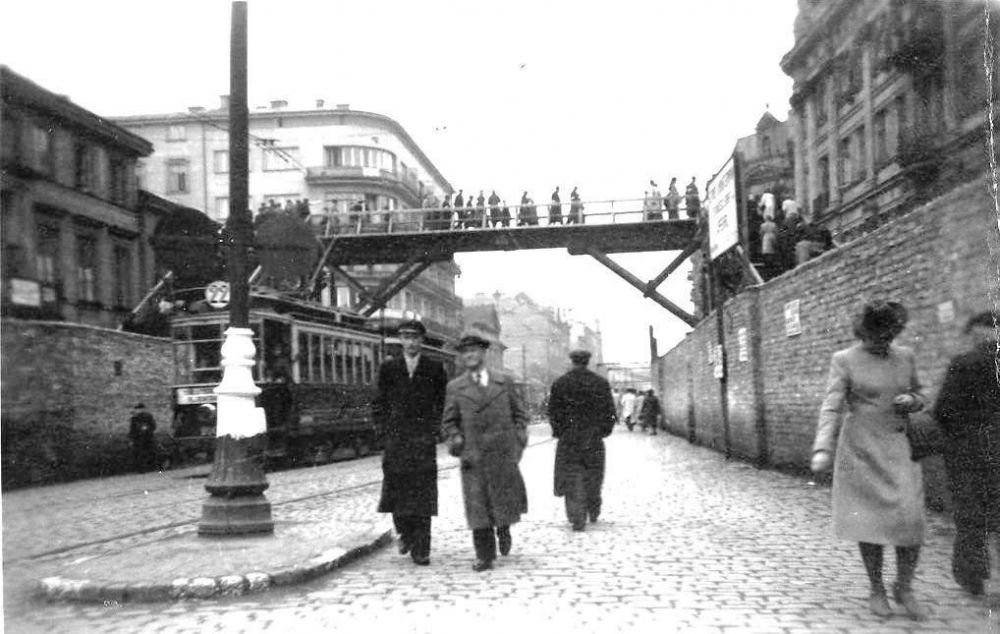- News
- Events
- Oneg Shabbat
- Collections
- Research
- Exhibitions
- Education
- Publishing Department
- Genealogy
- About the Institute
- Bookstore


During the occupation Chłodna, as an important exit road for the “Aryan” side of Warsaw, divided the ghetto into two parts. Here was the – as described by Professor Jacek Leociak — culmination point of the ghetto, the narrow walkway which allowed the population of the closed off district to cross from one part to the other.
South of Chłodna, which was an Aryan street (only in the early period of the ghetto’s existence, that is till December 1941, did part of Chłodna belong to the ghetto. It was an around 200 meter long section of road between the Żelazna and Wronia intersections.), lay the “big ghetto” with the majority of the poorest population. That’s where the paupers, the rehoused, the smalltime tradesmen and craftsmen lived. To the south lay the “small ghetto” where the richer people, the intelligentsia — an elite of sorts — lived. That’s where the Judenrat was as well as Sienna Street — considered one of the best streets in the ghetto.
Wanting to streamline traffic in the most crucial part of the Warsaw Ghetto, early in 1942 the Germans built a wooden footbridge for the pedestrians over Aryan Chłodna Street. For vehicular traffic, especially the rickshaws which were the most popular mode of transport in the ghetto, they installed a special mechanical gate at the intersection of Chłodna and Żelazna.
The bridge, designed and built by „Schmied and Muetzermann“, was set up near Chłodna 23 and Chłodna 26. It reached the third floor of the buildings, which allowed the “Aryan” trams, German military transports and cars to pass beneath it, as we can see in many photographs, which also depict pedestrians. The bridge provided a panoramic view of Aryan Warsaw. You could see the Hale Mirowskie trade centers, the fire station tower, the Saxon Garden, the Cedergren tower by Zielna Street (the PAST building), the crosses of churches and even the far-off shore of the Vistula. It was with good reason that the footbridge was often called Ponte dei Sospiri — the Bridge of Sighs.
This is what Henryk Makower wrote about the bridge in his journal:
From the bridge you can see the “Aryan” Warsaw, to us seemingly so free. But such small pleasures are not allowed. The policemen on the bridge politely but firmly ask you not to stare and keep moving.
This wooden bridge became burned into the memories of many people as well as the image of the ghetto itself, despite the fact that it functioned only for half a year from January to August 1942. After the great liquidation of the Warsaw Ghetto the footbridge was no longer necessary and was dismantled. But the extent to which it became the symbol, or the emblem, of the ghetto is evident in how often it appears in peoples’ memories as well as in literature — A. Rudnicki’s story The Great Stefan Konecki among others. It is also present in many photographs, you might in fact get the impression that it was one of the most photographed places in occupied Warsaw.
The bridge was also memorialized on film, appearing for example in the German propaganda chronicle filmed in the Warsaw Ghetto in May 1942. Among the many scenes, most of them staged, some show the bridge over Chłodna and the pedestrians crossing from one part of the ghetto to the other.
The footbridge over Chłodna, or rather a reconstructed version of it, appears also in Roman Polanski’s “The Pianist”. It is there that Władysław Szpilman meets his acquaintance and converses with him, which would be rather unlikely in reality since you were not allowed to stop on the bridge.
Since 2011 the place where the bridge over Chłodna stood holds an artistic installation called “A Footbridge of Memory”. Architect Tomasz Lec created the luminescent installation as part of the project to revitalize the historic part of the Wola district, destroyed during the war.